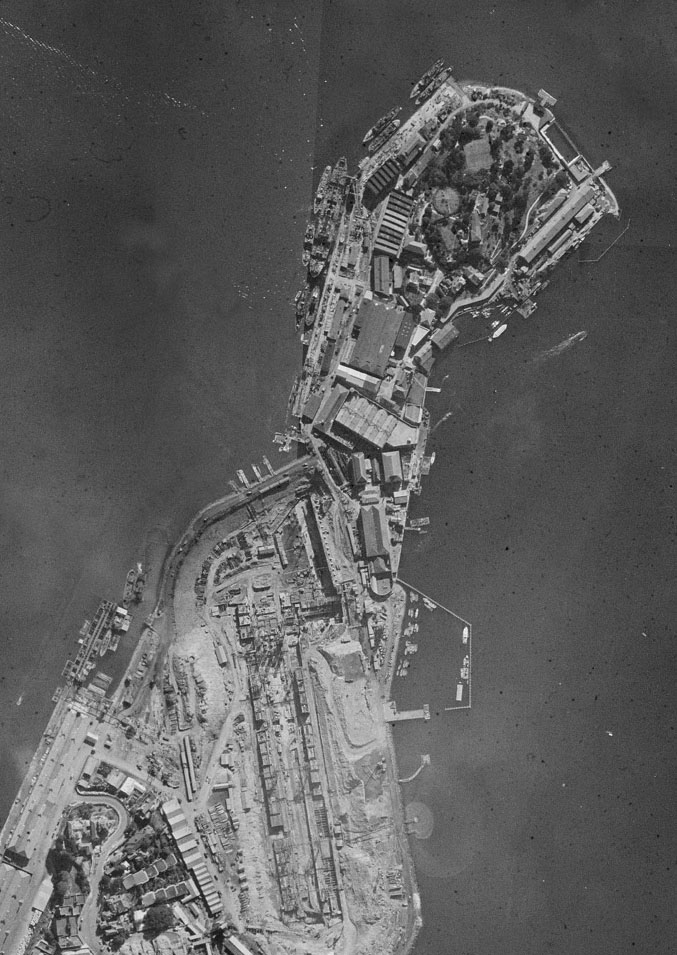Description
All of the scheduled trees are located on Garden Island at the northern extremity of the historic naval site. These trees are scattered informally within the open lawns, gardens, terraces and natural rock outcrops.
The composition includes three emergent accents. These tall, native Australian pines including two Hoop Pines (Araucaria cunninghamii) and a single Norfolk Island Pine (Araucaria heterophylla) have significant landmark values. These trees, ranging up to 22 metres in height, create a dramatic sense of scale in this prominent harbour ridge-top location.
The second major group includes the planted native figs – the Port Jackson Figs (Ficus rubiginosa) and Moreton Bay Figs (Ficus macrophylla). A number of specimens have achieved significant proportions. One Moreton Bay Fig, located in the upper north-western garden (adjacent to the tennis courts) is 20 metres in height with a canopy spread of 25 metres and 2m diameter basal area. A number of smaller Port Jackson Figs are also located along the cliff-line (see below for discussion). Other native rainforest species include the Queensland Firewheel Tree (Stenocarpus sinuatus), Plum Pine (Podocarpus elatus) and Brush Box (Lophostemon confertus). Evergreen exotics such as the Live Oak (Quercus virginiana) and Outeniqua Yellow-wood (Afrocarpus falcatus) together with palm accents including Canary Island Date Palm (Phoenix canariensis) reinforce a lush, subtropical thematic style which was typical of the late Victorian/ Federation periods. In addition, the Live Oak (18 metres in height) and Outeniqua Yellow-wood are both substantial individual specimens.
The steep sandstone cliffs and rock outcrops along the northern and north-western side of the landscaped hill-top have been largely cleared of native vegetation and modified to varying degrees including a high level of weed invasion. These areas display a multi-layered level of past weed management, rehabilitation with generic native species and more recent bush regeneration and restoration strategies which have included the re-introduction of locally native species. Most of the local native tree species including Smooth-barked Apple (Angophora costata) and Bangalay (Eucalyptus botryoides) on the steep northern slopes are believed to be relatively recent introductions (1980’s-1990’s). The parkland also contains a large range of earlier generic native planting dating from the late 1960’s to 1980’s period. These species include Tallowwood (Eucalyptus microcorys), Broad-leaved Paperbarks (Melaleuca quinquenervia) and Brush Box (Lophostemon confertus). Some of the more recent generic native component species are considered to be either neutral to intrusive with respect to the site’s overall context and heritage values.
Notably, the local native lithophyte – Port Jackson Fig (Ficus rubiginosa f. rubiginosa) continues to be a dominant component within the rocky outcrops. Some of these trees have attained substantial proportions (up to 15 metres in height) in these locations. Almost all of the natural vegetation has been removed in this location and throughout the City of Sydney LGA.
Significance
The Garden Island Precinct contains an outstanding collection of significant trees which date from the late nineteenth century and early twentieth century. The collection has group significance at the City/ LGA level in terms of its aesthetic, visual, historic, social and commemorative values. Furthermore, a number of specimens have individual significance at the local level.
Historical notes
The Garden Island/ Sydney Harbour Naval Precinct is an historic place of National significance and is scheduled on the Commonwealth Heritage List (as a Listed Place), Register of the National Estate, the State Heritage Register and classified by the National Trust of Australia (NSW). Garden Island has been a prominent part of Sydney and Australia’s naval history since the earliest days of British settlement.
The precinct contains an exceptional range of heritage values including a number of extremely rare intact elements such as its unified collection of nineteenth century naval buildings, chapel interiors, boatshed and slipway details and gardens. In 1788, the island was selected as the site for a garden to supply vegetables for the crew of HMS Sirius (Australian Heritage Database). A sandstone rock outcrop in the northern portion of Garden Island contains the carved initials “F.M.” believed to be “the oldest marks extant of white settlement” attributed to Frederick Meredith, member of the crew of HMS Sirius. Two other sets of initials dating from the same period are believed to exist. The precinct also has important associations with NSW Colonial Architect James Barnet. In 1940, during the middle of World War II, construction on the Captain Cook Graving Dock was commenced. This massive project was one of Australia’s largest at the time and connected the island to the mainland.
The eclectic landscape composition of the Naval Gardens on the northern ridge-top includes a number of individual emergent Araucaria specimens, native rainforest species and broadleaf exotics which was typical of the late Victorian and Federation periods. The planting palette and layouts are likely to have been influenced by Charles Moore and Joseph Maiden (Directors, Sydney Botanic Gardens 1848-1896 and 1896-1924). Aerial photos of the island in 1943 indicate numerous scattered and mature trees. Photos of the island from Mrs Macquaries Chair in 1889 show little in the way of tree planting and that most other natural vegetation had been cleared by this time. Photos from the 1890’s show numerous small trees planted around the upper levels of the northern most point. Substantial alterations to the remainder of the island were now well underway for use as a major naval base.


























